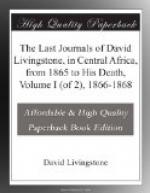Advantage has been taken by the people, of spots where the Lokuzhwa goes round three parts of a circle, to erect their stockaded villages. This is the case here, and the water, being stagnant, engenders disease. The country abounds in a fine light blue flowering perennial pea, which the people make use of as a relish. At present the blossoms only are collected and boiled. On inquiring the name, chilobe, the men asked me if we had none in our country. On replying in the negative, they looked with pity on us: “What a wretched, country not to have chilobe.” It is on the highlands above; we never saw it elsewhere! Another species of pea (Chilobe Weza), with reddish flowers, is eaten in the same way; but it has spread but little in comparison. It is worth remarking that porridge of maize or sorghum is never offered without some pulse, beans, or bean leaves, or flowers, they seem to feel the need of it, or of pulse, which is richer in flesh-formers than the porridge.
Last night a loud clapping of hands by the men was followed by several half-suppressed screams by a woman. They were quite eldritch, as if she could not get them out. Then succeeded a lot of utterances as if she were in ecstasy, to which a man responded, “Moio, moio.” The utterances, so far as I could catch, were in five-syllable snatches—abrupt and laboured. I wonder if this “bubbling or boiling over” has been preserved as the form in which the true prophets of old gave forth their “burdens”? One sentence, frequently repeated towards the close of the effusion, was “linyama uta,” “flesh of the bow,” showing that the Pythoness loved venison killed by the bow. The people applauded, and attended, hoping, I suppose, that rain would follow her efforts. Next day she was duly honoured by drumming and dancing.[35]
Prevalent beliefs seem to be persistent in certain tribes. That strange idea of property in man that permits him to be sold to another is among the Arabs, Manganja, Makoa, Waiyau, but not among Kaffirs or Zulus, and Bechuanas. If we exclude the Arabs, two families of Africans alone are slavers on the east side of the Continent.
30th November, 1866.—We march to Chilunda’s or Embora’s, still on the Lokuzhwa, now a sand-stream about twenty yards wide, with pools in its bed; its course is pretty much north or N.N.W. We are now near the Loangwa country, covered with a dense dwarf forest, and the people collected in stockades. This village is on a tongue of land (between Lokuzhwa and another sluggish rivulet), chosen for its strength. It is close to a hill named Chipemba, and there are ranges of hills both east and west in the distance. Embora came to visit us soon after we arrived—a tall man with a Yankee face. He was very much tickled when asked if he were a Motumboka. After indulging in laughter at the idea of being one of such a small tribe of Manganja, he said proudly, “That he belonged to the Echewa, who inhabited all the country to which I was going.” They are generally smiths; a mass of iron had just been brought in to him from some outlying furnaces. It is made into hoes, which are sold for native cloths down the Loangwa.




